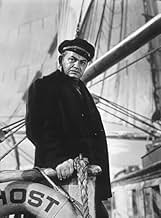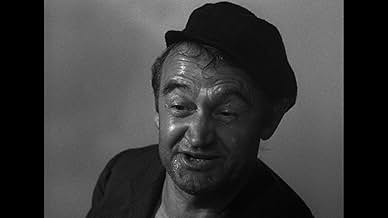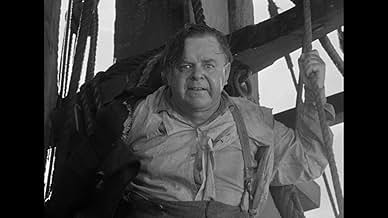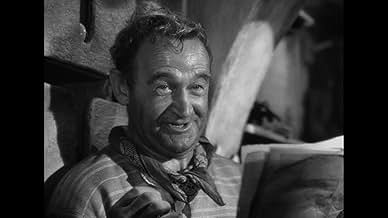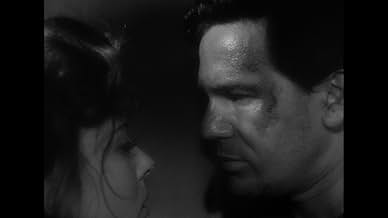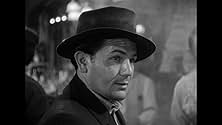IMDb RATING
7.5/10
4.8K
YOUR RATING
After being fished out of the sea by a sailing ship, three fugitives find themselves prisoners of the ship's brutal skipper who refuses to put them ashore, and they hatch an escape plan duri... Read allAfter being fished out of the sea by a sailing ship, three fugitives find themselves prisoners of the ship's brutal skipper who refuses to put them ashore, and they hatch an escape plan during a crew mutiny.After being fished out of the sea by a sailing ship, three fugitives find themselves prisoners of the ship's brutal skipper who refuses to put them ashore, and they hatch an escape plan during a crew mutiny.
- Nominated for 1 Oscar
- 2 nominations total
Ernie Adams
- Pickpocket
- (uncredited)
Cliff Clark
- First Detective
- (uncredited)
Jeane Cowan
- Singer
- (uncredited)
Richard Cramer
- Bartender
- (uncredited)
William Gould
- Second Detective
- (uncredited)
Ralf Harolde
- Agent Getting Johnson Shanghaied
- (uncredited)
Oscar 'Dutch' Hendrian
- Crewman
- (uncredited)
- Director
- Writers
- All cast & crew
- Production, box office & more at IMDbPro
Featured reviews
Good film that combines action and psychology and film noir. Edward G. Robinson stars as Larson, the cruel captain of the Ghost, a ship no one wants to sail on. John Garfield and Ida Lupino are people running away from their pasts, and Alexander Knox is an unlucky writer. These three people end up on the Ghost through coincidence. Also onboard are Gene Lockhart as a boozy doctor and Barry Fitzgerald as a psychotic cook. All 5 stars are great in this neat little film that bears little resemblance to the Jack London novel, but who cares. Beautifully filmed with lots of fog and terrific closeups. Garfield and Lupino make a great couple and match each other angst for angst. Knox is best remembered for his starring role in Wilson but is very effective here as well. Robinson seemingly could play any role. He must stand as the most underrated actor of the 30s and 40s. Never Oscar nominated, Robinson nevertheless had a career that spanned decades and never gave a bad performance. The Sea Wolf is a definite nominee for anyone's "must see" list.
"I've spit in the eye of better men than you for saying less", boatswain John Garfield snarls at sadistic captain Edward G. Robinson in this gritty film noir, set in the open sea, but fenced in, very noir-like, by constant dense fog.
I believe Raoul Walsh would have made a more dynamic film over Jack London's novel than Michael Curtiz did, but it is still a pretty good watch any day of the week. Robert Rossen wrote the screenplay which is well-structured, but far too literal and talkative for the pacing of a dramatic work of art. The lighting of the set, basically just the ship 'The Ghost', is brilliant, Erich Wolfgang Korngold's score must count among his best, highly effective and evocative.
Acting is on a very high level, with Robinson grabbing a first prize for his portrayal of the complex sadist 'Wolf' Larson. John Garfield is his swarthy and sexy adversary, and Barry Fitzgerald turns his signature role of the Irish leprechaun on its head with his vicious, diabolical snitch of a sailor, truly scary, a virtuoso performance.
I believe Raoul Walsh would have made a more dynamic film over Jack London's novel than Michael Curtiz did, but it is still a pretty good watch any day of the week. Robert Rossen wrote the screenplay which is well-structured, but far too literal and talkative for the pacing of a dramatic work of art. The lighting of the set, basically just the ship 'The Ghost', is brilliant, Erich Wolfgang Korngold's score must count among his best, highly effective and evocative.
Acting is on a very high level, with Robinson grabbing a first prize for his portrayal of the complex sadist 'Wolf' Larson. John Garfield is his swarthy and sexy adversary, and Barry Fitzgerald turns his signature role of the Irish leprechaun on its head with his vicious, diabolical snitch of a sailor, truly scary, a virtuoso performance.
The Jack London book on which the film is based is rich in characterizations and philosophy, but rather poorly constructed and plotted. Rossen has substantially and quite artfully turned this into a rather taught seaborne suspense picture. What we lose is much of what makes Wolf Larsen into one of the greatest anti-heroes in literature. That is really only alluded to in the film. What we gain is the integration of the Maud story-line, correcting the worst flaw of the novel. It's a masterful solution showing just how good of writer Rossen was. Don't watch this to write a book report on the novel though. The plot is completely reworked. Garfield and Robinson are tremendous. Ida Lupino is too, for what little we see of her. Her power helps make the Maud character big enough to make sense. Any lesser actress would have been as submerged as... Well I can't say, that would spoil it.
One of the great classics Directed by the gifted tyrant Micheal Curtiz. Every performance is excellent with Edward G. giving one of his best. Curtiz did not make boring films, this speeds along at under 90 minutes without a dull moment. The miniature work is even good, note the scene near the beginning with the row boat in the bay. That is a miniature in a tank but pretty damn convincing. Flawless and gripping.
It's amazing what a really good actor can pull off. In the Jack London novel on which this film was loosely based, Wolf Larson is tall, blond, Scandinavian, an "ubermensch" flaunting his invincible strength and power over other men. Edward G. Robinson was very short and dark, almost gnome-like with little stubby hands, a homely face and nasal voice. Yet somehow he fills this improbable role, making Larson at once larger than life and credibly human.
Larson is, of course, the "sea wolf" of the title, captain of the Ghost, a mysterious, perpetually fog-enshrouded schooner. Manned by a crew of brutal and brutalized men, the ship is ostensibly hunting seals, but its real destination is a show-down with Wolf's brother, the even more colorfully named Death Larson. We never learn much about this sibling feud, or about the backgrounds of the major characters. Aside from Larson, there is George Leach (John Garfield), who signs on with the ship to escape a prison rap, and two passengers rescued from the wreck of a ferry in San Francisco harbor: Ruth (Ida Lupino), an escaped convict, and Van Weyden, a well-bred writer who becomes, as observer and interpreter of the action, the film's central consciousness. Larson refuses to put the two castaways ashore, seemingly out of pure spite. Leach plots to escape the ship, and the threat of mutiny hangs in the air.
As this summary suggests, the movie's plot is as foggy as its atmosphere, but this doesn't matter very much. The atmosphere, at once raffish and eerie, and the beautifully drawn characters provide plenty of interest, and there is also a serious and compelling theme. Larson's motto (from Milton) is "better to reign in hell than serve in heaven." Van Weyden, who becomes the secretly intellectual captain's confidant, realizes that Larson is afraid to leave his ship because only as its captain can he enjoy absolute power; on shore he would be forced to compete with his equals and betters. His sport is humiliating his victims and stripping them of dignity and self-respect. He gratuitously insults and torments all those who attempt to challenge him: in addition to Leach and Ruth, there is Louis (the excellent Gene Lockhart), a broken, alcoholic doctor who tries to recover his dignity after saving Ruth's life with a transfusion of Leach's blood. Larson won't let him, of course, and his desperate response prompts the writer's comment, "There is a price no man will pay for living." Larson even turns against Cookie (Barry Fitzgerald), his most loyal crew-member. Fitzgerald is spectacularly loathsome, shrieking with laughter and scuttling around his galley like a demonic leprechaun.
John Garfield, to his credit, was never reluctant to take supporting roles in films he admired. His part here, while secondary, is a pip: a defiant young roughneck, smarting with wounded pride, looking terrific in a tattered sweater and fisherman's cap. He gets a great introduction in the first scene, walking into a waterfront dive where he brushes off a pickpocket ("If you find anything in there, brother, I'll share it with you") and knocks out the recruiter who tries to slip him a mickey. On board the Ghost, he's the only one of the sailors who rebels against Larson; when ordered to address the captain with respect, he manages to make "sir" sound like a four-letter word. "Don't worry," he says before the transfusion, "This kind of blood never cools off."
Ida Lupino is wonderful (when was she not?) as the convict who has lost her spirit; her pathetic lady-like act keeps giving way to flashes of anger and underlying sadness. She and Garfield make a perfect couple, and their romance, which could have seemed like a sop to the box office, is deeply touching. Like Garfield, Lupino regularly played tough, resentful hard-luck kids. But her pale, waif-like delicacy and wistfulness contrast nicely with Garfield's rough-hewn sturdiness and combustible temper. They have three good scenes together: one where she finds him huddled like a whipped puppy in the ship's hold (he has been beaten after assaulting the captain) and they smoke cigarettes together. Initially hostilehe tells her scornfully that he only stood up for her because "I can't even stand to see a dog beg, much less a human being"they quickly bond. He urges her to keep fighting and boasts that Larson can never break his spirit, while she wearily responds that nothing makes any difference to her anymore. Later they talk in a doorway, Ida in her nightgown, and he touches her arm, realizing that his own blood is running through it. They don't kiss, but their chemistry is palpable. Finally they play a love scene on either side of a locked iron door, whispering to each other with their lips touching the wall between them.
Eventually Larson's invincibility starts to crack, as he suffers from crippling migraines and hysterical blindness. He remains too vicious to arouse any pity, but Robinson makes him a fascinating monster. He conveys such a dominant, overpowering will that you hardly notice he's not physically imposing; his sneering voice, nasty laugh and devious intelligence make him genuinely scary. The intense performances of the whole cast knit together this unusual blend of boy's-adventure-story entertainment and serious drama, a classic of the Warner Brothers' minor-key style.
Larson is, of course, the "sea wolf" of the title, captain of the Ghost, a mysterious, perpetually fog-enshrouded schooner. Manned by a crew of brutal and brutalized men, the ship is ostensibly hunting seals, but its real destination is a show-down with Wolf's brother, the even more colorfully named Death Larson. We never learn much about this sibling feud, or about the backgrounds of the major characters. Aside from Larson, there is George Leach (John Garfield), who signs on with the ship to escape a prison rap, and two passengers rescued from the wreck of a ferry in San Francisco harbor: Ruth (Ida Lupino), an escaped convict, and Van Weyden, a well-bred writer who becomes, as observer and interpreter of the action, the film's central consciousness. Larson refuses to put the two castaways ashore, seemingly out of pure spite. Leach plots to escape the ship, and the threat of mutiny hangs in the air.
As this summary suggests, the movie's plot is as foggy as its atmosphere, but this doesn't matter very much. The atmosphere, at once raffish and eerie, and the beautifully drawn characters provide plenty of interest, and there is also a serious and compelling theme. Larson's motto (from Milton) is "better to reign in hell than serve in heaven." Van Weyden, who becomes the secretly intellectual captain's confidant, realizes that Larson is afraid to leave his ship because only as its captain can he enjoy absolute power; on shore he would be forced to compete with his equals and betters. His sport is humiliating his victims and stripping them of dignity and self-respect. He gratuitously insults and torments all those who attempt to challenge him: in addition to Leach and Ruth, there is Louis (the excellent Gene Lockhart), a broken, alcoholic doctor who tries to recover his dignity after saving Ruth's life with a transfusion of Leach's blood. Larson won't let him, of course, and his desperate response prompts the writer's comment, "There is a price no man will pay for living." Larson even turns against Cookie (Barry Fitzgerald), his most loyal crew-member. Fitzgerald is spectacularly loathsome, shrieking with laughter and scuttling around his galley like a demonic leprechaun.
John Garfield, to his credit, was never reluctant to take supporting roles in films he admired. His part here, while secondary, is a pip: a defiant young roughneck, smarting with wounded pride, looking terrific in a tattered sweater and fisherman's cap. He gets a great introduction in the first scene, walking into a waterfront dive where he brushes off a pickpocket ("If you find anything in there, brother, I'll share it with you") and knocks out the recruiter who tries to slip him a mickey. On board the Ghost, he's the only one of the sailors who rebels against Larson; when ordered to address the captain with respect, he manages to make "sir" sound like a four-letter word. "Don't worry," he says before the transfusion, "This kind of blood never cools off."
Ida Lupino is wonderful (when was she not?) as the convict who has lost her spirit; her pathetic lady-like act keeps giving way to flashes of anger and underlying sadness. She and Garfield make a perfect couple, and their romance, which could have seemed like a sop to the box office, is deeply touching. Like Garfield, Lupino regularly played tough, resentful hard-luck kids. But her pale, waif-like delicacy and wistfulness contrast nicely with Garfield's rough-hewn sturdiness and combustible temper. They have three good scenes together: one where she finds him huddled like a whipped puppy in the ship's hold (he has been beaten after assaulting the captain) and they smoke cigarettes together. Initially hostilehe tells her scornfully that he only stood up for her because "I can't even stand to see a dog beg, much less a human being"they quickly bond. He urges her to keep fighting and boasts that Larson can never break his spirit, while she wearily responds that nothing makes any difference to her anymore. Later they talk in a doorway, Ida in her nightgown, and he touches her arm, realizing that his own blood is running through it. They don't kiss, but their chemistry is palpable. Finally they play a love scene on either side of a locked iron door, whispering to each other with their lips touching the wall between them.
Eventually Larson's invincibility starts to crack, as he suffers from crippling migraines and hysterical blindness. He remains too vicious to arouse any pity, but Robinson makes him a fascinating monster. He conveys such a dominant, overpowering will that you hardly notice he's not physically imposing; his sneering voice, nasty laugh and devious intelligence make him genuinely scary. The intense performances of the whole cast knit together this unusual blend of boy's-adventure-story entertainment and serious drama, a classic of the Warner Brothers' minor-key style.
Did you know
- TriviaThe first movie to have its world premiere on a ship: the luxury liner "America", during a trip from San Francisco to Los Angeles.
- GoofsUntil the era of the 1st World War, the practice on board a ship was to call orders for the helmsman to move the tiller either to port or to starboard. Calling "hard a-port" meant moving the tiller to port, which means the rudder and the vessel, will then move to starboard. With wheel steering, putting the helm/tiller to port, means spinning the wheel to starboard. Ships no longer use this system - these days helm directions refer to the desired turn of the rudder/vessel. The James Cameron movie "Titanic" also contained a similar scene, which generated a lot of puzzlement. It IS a bit confusing at first, unless one is a sailor and is familiar with tiller steering.
- Quotes
Humphrey Van Weyden: There's a price no man will pay for living.
- Alternate versionsThe film was cut by approximately 12 minutes down to less than 90 minutes for re-issue. The deleted footage consisted of little, but integral, moments throughout the story which added considerably to the quality of the film as a whole. For many years, the only known existing print of the original 99-minute theatrical version was a 16mm print which belonged to the film's star, John Garfield. However, Warner Brothers studio recently discovered a 35mm print of this original version at the Museum of Modern Art in New York City. It was subsequently restored and used for distribution on DVD and Blu Ray.
- ConnectionsEdited into Le loup de mer (1993)
- SoundtracksHello! Ma Baby
(uncredited)
Music by Joseph E. Howard
Lyrics by Ida Emerson
Played on piano and sung by Jeane Cowan in the bar
Details
Box office
- Budget
- $1,013,217 (estimated)
- Gross worldwide
- $6,192
- Runtime1 hour 40 minutes
- Color
- Aspect ratio
- 1.37 : 1
Contribute to this page
Suggest an edit or add missing content


